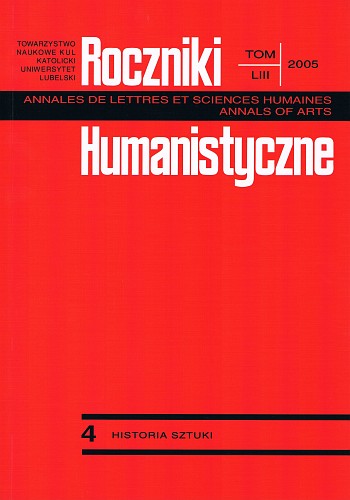Drewniane rzeźby lwów w polskiej sztuce gotyckiej
Wooden Sculptures of Lions in Polish Medieval Art
Author(s): Agnieszka BryłaSubject(s): Fine Arts / Performing Arts, Architecture
Published by: Towarzystwo Naukowe KUL & Katolicki Uniwersytet Lubelski Jana Pawła II
Keywords: lion; sculpture; wood; Cistercians
Summary/Abstract: The subject of the article “Wooden sculptures of lions in Polish medieval art” are lying lions grouped in bigger complexes of sculptures. Twenty-nine of them are assembled in the circle of the Cistercian order - in Cistercian and post-Cistercian churches and monasteries in the whole area of Poland, that is in Koprzywnica, Sulejów, Szczyrzyca, Kraków-Mogiła, and Ląd upon Warta. The remaining twenty-four sculptures of lions are found in parish churches or in other places that are not connected with the Cistercian order in Poland, i.e. in Dobre Miasto, Leżajsk, Borek Wielkopolski and Koźmin Wielkopolski.The Middle Ages are the time when the lions are believed to have been sculptured, and the researchers usually point to the 13-16th centuries. In some cases (Ląd upon Warta, Borek Wielkopolski, Koźmin Wielkopolski) the lions are dated to a later period, namely to the 17-18th centuries, and they are pointed to as a continuation of the medieval type of the “bearing lion” .In their form the sculptures are a continuation of the stone and bronze works of European medieval sepulchral art. The functional form of the bodies of the lions that suggests bearing weights, as well as the movable character of the wooden figures lead one to suppose that they were part of the catafalque construction for bearing the coffin during funeral celebrations. Lions with cushions on their backs in the post-Cistercian churches in Sulejów and Koprzywnica could be used as seats for holding a vigil over the dead, which was the usual practice during funeral services.In the context of sepulchral art the lion expresses the eschatological truth, that is defeating death by Christ and Ressurection. It is a sign of faith and of hope for an eternal life.
Journal: Roczniki Humanistyczne
- Issue Year: 53/2005
- Issue No: 04
- Page Range: 169-183
- Page Count: 15
- Language: Polish

